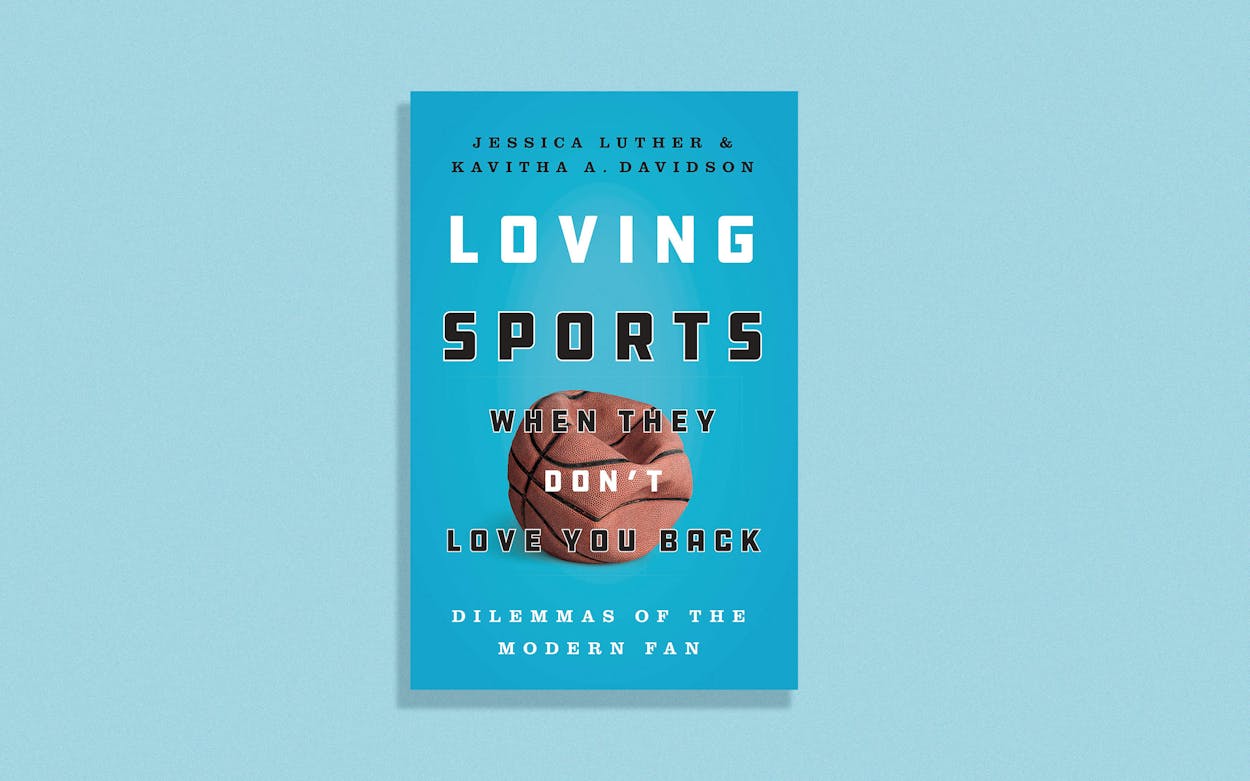To be a woman who loves sports, even in 2020, is to defy stereotypes. As authors Jessica Luther and Kavitha A. Davidson write in the introduction to their new book, Loving Sports When They Don’t Love You Back: Dilemmas of the Modern Fan, they both experience bias on a frequent basis. Luther describes how her husband, who doesn’t share her interest in sports, frequently “begs off the sports talk with other men, telling them to talk to his wife instead.” Davidson knows to expect surprised reactions from the men around her when she pipes up to comment while watching a game in a bar. They’re even more taken aback when they find out she’s not just a casual fan, but a professional sportswriter with years of expertise.
Published this month by the University of Texas Press, Loving Sports When They Don’t Love You Back goes far beyond addressing sexism in sports. It’s a wide-ranging and incisive look at systemic injustice across the industry: homophobia, domestic violence, doping, racist mascots, brain injuries, corruption, and the controversy over whether to pay student athletes. Luther, an Austin journalist who’s spent years reporting on sexual assault in sports (and who, with Texas Monthly’s Dan Solomon, broke the news of a 2015 sexual assault scandal at Baylor University), and Davidson, a former ESPNw columnist who hosts the Athletic’s podcast The Lead, spoke with Texas Monthly about how sports are inherently political—and why fans shouldn’t look away from the problems with the games they love.
Texas Monthly: What was the driving force behind this book? Did a single issue trigger a thought that led to another and evolved into this book?

Jessica Luther: There was no single issue. A friend had put it in my head years ago to do a book on problems within sports with which a fan might struggle. Then at some point, Kavitha and I were joking (but maybe not joking) about writing something in response to pieces that are published every year with titles like, “What Men Want: 9 Rules for Watching Football With Guys” or “How to Keep Your Relationship Alive With a Sports-Obsessed Guy.”
Kavitha Davidson: No shade at all to the women who want those guides, but they never, ever represented us or the other women we know who love sports. And they reinforced just how much work it takes for us to merely exist in this space, how difficult it can be to find media that speak to us.
JL: We were thinking of doing a snarky rejoinder from our perspective as women in sports who are constantly having to prove our fandom. Luckily, the project landed at the University of Texas Press in the very capable hands of Casey Kittrell, our editor, who steered us to this more serious, journalistic (though not entirely without snark) version.
TM: As a Hispanic female sportswriter who covered the Dallas Cowboys in the eighties, I was disheartened to read that men, and mostly white men, still make up about 90 percent of all sportswriters today. What will it take to make the profession more diverse?

KD: If you look at the data on editors, reporters, columnists—at both the local and national levels—the numbers are staggering and depressing. It seems like very little has changed to diversify newsrooms, and sports newsrooms are by far the worst culprits of this. And when women, or people of color, or LGBTQ folks make those inroads, it’s seen by many (not all) as an encroachment.
JL: It’s not enough just to hire more diverse staff. You have to cultivate spaces where they can thrive and where they can ultimately become the people who help make hiring decisions. I think fans should know—and we try to demonstrate in the book—that there are a lot of people from marginalized groups doing great work throughout sports media, so you should seek out those voices, and read and watch their work.
TM: How should the media handle coverage of an athlete who’s accused of domestic violence?
JL: This is a topic near and dear to me, as it’s been the main one in my career over the last seven years. I think there’s no one single answer for how off-field interpersonal violence should be handled within sports stories. I do think there’s room for straight-up sports stories that stick to what happened during game play, where those details are not necessary. But outside of game reports, so much of sports coverage is talking about players and coaches as citizens of the world. If a team brings someone on who has a known history of violence, that’s worthy of interrogation.
There’s also this added layer with sports: they encourage people to cheer for players and, sometimes, coaches. So, when we know someone has harmed someone else in their off-field or off-court life, it can sting in a particular way to hear people cheering for that person. We live in a society that so rarely takes domestic violence or sexual assault seriously, and now here we are cheering on someone who has done harm—that can be a jarring experience. I have no easy answer to this question.
TM: Many fans prefer to look at the sport in a vacuum—hence the infamous call for politically active athletes to “stick to sports.” Why is it necessary for a twenty-first-century fan to widen the lens and see politics in sports, racist mascots, inequities, doping, and corruption? How much power do fans actually wield?
JL: There are multiple reasons why it’s necessary for fans to widen their lenses. In part, it’s to make more people feel welcome in sports. In part, it’s because some of what happens in sports is actually harmful (racism, sexism, homophobia, transphobia, ableism, etc.), and we should all be in the business of mitigating harm. But it’s also because college and professional sports are big money. They put money in local communities and they certainly take it, too, often from local government funded by the taxpayer.
KD: I think fans have more power than they realize, especially when it comes to influencing brands and then, by extension, leagues and teams. Nielsen had a study in July where they asked sports fans how they feel about Black Lives Matter, and the majority of fans said they supported the movement—but more importantly, they also said they supported athletes, brands, and teams supporting the movement. That’s how you get Nike doing BLM ad campaigns with Colin Kaepernick, and that’s how you get FedEx and a number of investors reading the room and essentially forcing the Washington football team to change its name.
TM: The book also explores the lasting effects of head trauma in football and other dangerous sports. Are those risks the reason fans follow risky sports, and if we make the game safer, will the appeal remain the same?
KD: Much of the reason fans like those sports is their inherent brutality, and there’s no getting around that. While a lot of the issues we discuss in the book are fixable, the physical danger of football is not. There’s no such thing as “safe football.” But at the same time, athletes have the right to assume that risk, as long as they have all the information.
I interviewed a bull rider who had been thrown from the bull, broken his neck, was paralyzed, and eventually, miraculously, recovered—and he went right back to bull riding. And when asked about this, he said, “I’m just a cowboy. This is what I know and love.” And it’s not our place to tell people they don’t have the right to think that way. The most we can ask for is that leagues educate their athletes on these risks, stop blocking scientific research, and provide them with doctors who truly have their health as their number-one priority—in addition to striving for societal pressures to be more equal, so that the athletes who go into “gladiator sports” aren’t just from lower socioeconomic backgrounds.
TM: You make the case that, in part, the media’s lack of attention plays a role in women’s sports not gaining national traction. How can women’s coverage improve?
JL: I do think the product of women’s collegiate and professional sports often speaks for itself. Once people have a chance to watch it even a little bit, they will quickly figure out that, like most sports, it is fun to watch. But as we talk about in the book, it’s always a bit of a chicken and egg situation: we are told by the powers that be that more money and attention will not be given to the women’s game until support for the game increases, but support for the game cannot increase unless money and attention is invested. The truth is, women’s sports has proven over and over again that there are significant audiences for it: 1.2 billion people watched the Women’s World Cup in 2019, for example. If anything, women’s sports is an untapped market and should be sold as such. There are so many fans just waiting for good, consistent coverage. Convincing a bunch of men of that, well, that can be a challenge.
TM: You discuss how the NCAA has not embraced calls to pay student athletes. In my experience teaching at the university level, I’ve heard many students oppose paying players they root for. How would you convince the student baristas who put themselves through college, only to graduate with mounds of student debt, that in the interest of fairness, the scholarship athlete needs more?
JL: I think the student baristas are upset at the wrong people in this scenario. The money is there either way, it’s just going into the pockets of administrators and coaches (and not just head coaches, but assistants and trainers and anyone associated with the team except the athletes). Athletes and baristas are both laborers, but only the latter is allowed to get paid while also being a student. This isn’t to say that having big money in college sports is fair, but if the issue is that there is big money in college sports and/or a crisis of student debt in this country, that is not the athletes’ fault. All the students should unite and push for more equity across the board when it comes to where money goes in higher education and who is actually footing the bill.
TM: What message do you hope readers will take away from your book?
JL: We hope that people who love sports but don’t feel loved back see themselves in this book and know they are not alone. That they see that we struggle as fans but also that we love sports. That it’s possible to hold these tensions and still tune into games. That it’s also okay to decide that when something hurts you, you can give it up.
KD: I hope fans find some comfort and community, that they realize others have the same dilemmas they do, and that it’s okay that we don’t always know what to do with that. Sitting with the discomfort of being a sports fan might be the book’s biggest takeaway.
This interview has been edited for length and clarity.






